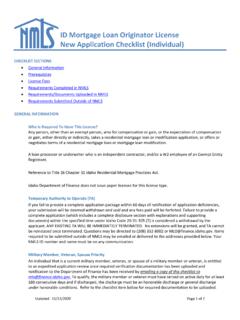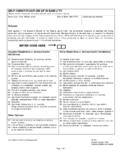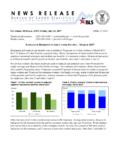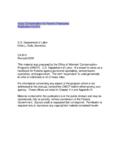Transcription of FREQUENTLY ASKED QUESTIONS IMPLEMENTING THE …
1 1 FREQUENTLY ASKED QUESTIONS IMPLEMENTING THE EMPLOYMENT TAX INCENTIVE Why will there be an employment tax incentive? Millions of young South Africans are currently unable to participate in economic activity, and as a result suffer disproportionately from unemployment, discouragement and economic marginalisation. High youth unemployment means young people are not gaining the skills or experience needed to drive the economy forward. This lack of skills can have long-term adverse effects on the economy. In South Africa the current lack of skills and experience as well as perceptions regarding the restrictiveness of labour regulations make some prospective employers reluctant to hire the youth. South African employers now have the opportunity to facilitate increased employment of young work seekers.
2 What is the employment tax incentive? It is an incentive aimed mainly at encouraging employers to hire young and less experienced work seekers. It will reduce the cost to employers of hiring young people through a cost-sharing mechanism with government. This incentive will complement existing government programmes with similar objectives. The incentive will be implemented on 1 January 2014. Who will qualify? The employer is eligible to receive the employment tax incentive if the employer o Is registered for employees tax (PAYE); o Is not in the national, provincial or local sphere of government; o Is not a public entity listed in Schedule 2 or 3 of the Public Finance Management Act (other than those public entities designated by the Minister of Finance by Notice in the Gazette); o Is not a municipal entity; o Is not disqualified by the Minister of Finance due to displacement of an employee or by not meeting such conditions as may be prescribed by the Minister by regulation.
3 2 An individual is a qualifying employee if he or she o has a valid South African ID or an asylum seeker permit; o is 18 to 29 years old [please note that the age limit is not applicable if the employee renders services inside a special economic zone (SEZ) to an employer that is operating inside the SEZ, or if the employee is employed by an employer that operates in an industry designated by the Minister of Finance]; o is not a domestic worker; o is not a connected person to the employer; o was employed by the employer or an associated person to the employer on or after 1 October 2013; and o is not an employee in respect of whom an employer is disqualified to receive the ETI ( the employee is paid below the minimum wage applicable to that employer or paid a wage below R2 000 per month if a minimum wage not applicable).
4 Tip: There is no limit to the number of qualifying employees that an employer can hire. How does it work? The employer will calculate and claim the incentive on a monthly basis, and must follow these steps: Identify all qualifying employees in respect of that month; Determine the applicable employment period for each qualifying employee; Determine each employee s monthly remuneration ; and Calculate the amount of the incentive per qualifying employee as per the table below: Monthly Remuneration Employment Tax Incentive per month during the first 12 months of employment of the qualifying employee Employment Tax Incentive per month during the next 12 months of employment of the qualifying employee R 0 - R2 000 50% of Monthly Remuneration 25% of Monthly Remuneration R 2 001 - R4 000 R1 000 R500 R 4 001 - R6 000 Formula: R1 000 ( x (Monthly Remuneration R4 000)) Formula: R500 ( x (Monthly Remuneration R4 000)) 3 In determining the first or the second 12-month period, only the months in which the employee was a qualifying employee are taken into account.
5 For example, the employee may be a qualifying employee in the first three months but not a qualifying employee in the fourth and the fifth months. If the employee is a qualifying employee in the sixth month, the sixth month is month number four as far as the 12-month period is concerned. Tip: For the next biannual reconciliation submission process in 2014, the EMP501 and IRP5 will also be updated with the necessary fields. How long will it be available? The incentive is currently scheduled to end on 31 December 2016 but its effectiveness will be reviewed to determine whether to continue with the incentive. Need help? Call the SARS Contact Centre on 0800 00 SARS (7277), or visit your nearest SARS branch. When will the employment tax incentive be unavailable to the employer in a specific month?
6 An employer cannot reduce its PAYE liability if on the last day of that month, the employer has failed to submit any return; has any tax debt outstanding, excluding where an agreement has been concluded for a deferral payment; where an agreement has been concluded for compromise of a tax debt; where a tax debt has been suspended pending an objection or appeal; or where the tax debt is less than R100. How does the roll-over of the employment tax incentive work?\ An incentive amount may be rolled over if the incentive amount available exceeds employees tax due in a month. The excess may be carried forward to the next month; if the employer does not reduce the PAYE by the employment tax incentive, despite the employment tax incentive being available to that employer; and 4 if the employment tax incentive was not available to the employer due to non-compliance.
7 The employment tax incentive is deducted in the month in which the employer corrects the non-compliance. Tip: On the first day of the month following the end of the period covered by the PAYE reconciliation ( 1 September or 1 March each year), the rolled-over amounts may not exceed R6 000 in respect of each qualifying employee who is in the employment of that employer on that date. Are there any penalties for non-compliance? Where the employer claims an employment tax incentive in respect of the employee whom he/she paid less than the minimum wage (or less than R2 000 where minimum wage is not applicable), the employer is liable for a penalty equal to 100% of the employment tax incentive received in respect of that employee (in addition to paying back the incentive to SARS).
8 Further, where the employer is deemed to have displaced an employee, the employer is liable to pay a penalty of R30 000 in respect of that employee. ENDS.
















